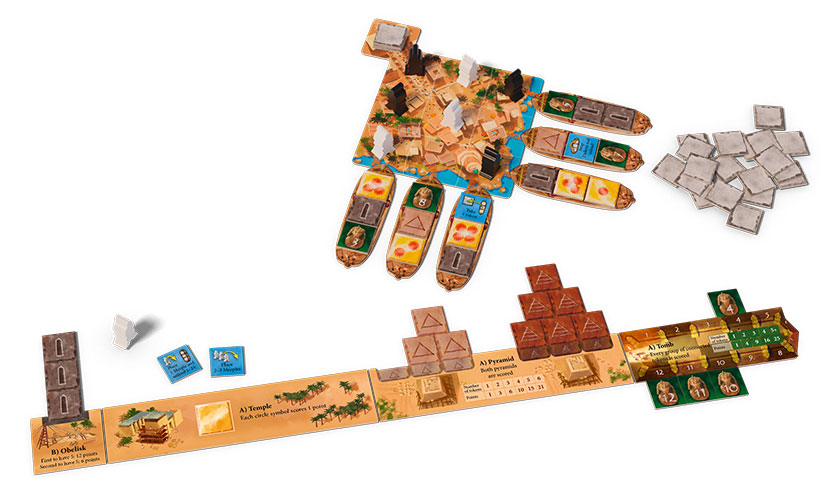Uwe Rosenberg’s Patchwork is one of the best pure two-player games on the market, combining polyomino tiles, a rondel mechanism for tile selection, and a little bit of take-that into a fun but reasonably intense two-player experience. His newest two-player title, Fairy Trails, is something quite different for him, a lighter game in both theme and mechanics, but unfortunately it falls a bit short of his prior standard, including cute art I thought made the game harder to play.
Fairy Trails comprises a deck of cards, each of which shows two colors of trails on it extending out to all four sides, and nineteen tokens per player. On each turn, you will play one of the three cards in your hand to the table, and will try to complete trails in your color. Some of those cards show trails ending in cul-de-sacs, but most extend the trails to one or two other edges of the cards, so finishing them involves a little advance planning. Trails also have spaces on them for houses, and once you’ve completed a trail in your color – meaning that the trail is closed at all ends, with nothing terminating at a card edge – you can place your tokens on all of those house spaces. The first player to place their 19th house token wins.
The game’s simplicity is its best feature; there’s almost no learning curve here. Once you see how the trails work, and that you aren’t just looking for cul-de-sacs but need to try to loop your trails back to themselves, and can also stymie your opponents by making that harder, you have the game’s mechanics. Turns aren’t necessarily that quick, however, because of the number of permutations you have to work through to choose which card to place, where to place it, and then which orientation, most of which won’t end up closing a trail completely, leaving you to consider whether to extend an existing trail, hoping to get more house tokens on it when it’s completed, or move it closer to completion.
That leads to the game’s biggest issue, the art, which is pretty enough but makes parsing the trails’ routes much harder. The two colors are distinct enough, but the trails overlap each other in confusing ways, making it hard to see the trail that’s ‘underneath’ the other one, and since the background of the yellow trails is a grayish-purple, it looks too much like the color of the fuchsia trails. The trails are also drawn in a wispy style, like a font with too many serifs, which may improve the aesthetic value but also contributes to the confusion about where the trails go. The dark green backgrounds also don’t quite help – they don’t provide enough contrast with the two trail colors, yellow and fuchsia.

My other main complaint with Fairy Trails is that the mechanics themselves aren’t that interesting; it’s like a poor man’s Carcassonne, where your moves are somewhat limited by your cards, but here you can’t try to jump into your opponent’s trail to steal points, and with just a single feature to complete and score, the game is kind of repetitive. You can add a card to make it harder for your opponent to close one of their roads, which means they can’t place any house tokens on it, but you might do so at the expense of a move that would help close one or your trails, or extend it in a way that’s more profitable when you do close it, so the take-that element exists but is of limited strategic value.
I had a hard time teasing apart the two problems I had with Fairy Trails. Would I like the game more if the art weren’t visually confusing, so that evaluating moves or scoring trails was faster? Rosenberg’s heavier worker-placement games often suffer from a surfeit of mechanics and scoring options; would the art here have bothered me less if, say, there were one more way to score, or one other option beyond just building trails? I did play this with a younger player who likes games, but she ended up losing interest halfway through, I think because it was such a long process to close her trails and place tokens on them. Fairy Trails seems like the core concept for a good, light two-player game is somewhere in here, but it’s not finished the way that Rosenberg’s games usually are.

